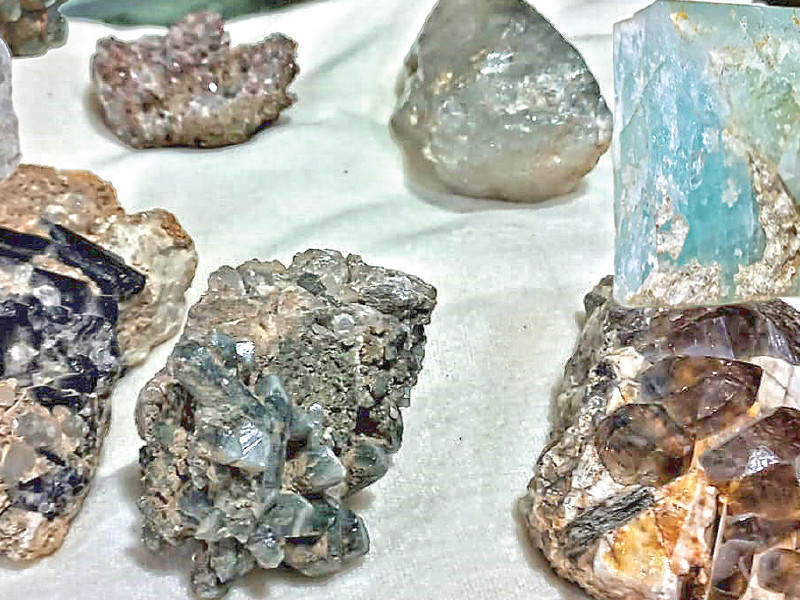GILGIT/SKARDU:
The harsh licensing process and lack of technical efficiency have subdued the glittery economy of the gemstone sector—often termed as “the gems of hope.”
In the extreme north of Pakistan, in the scenic region of Gilgit-Baltistan (G-B), lies a vast labyrinth of valleys, mountains, and cliffs where dreams are forged and fortunes are made. Yet miners and traders must navigate a maze in a quest to obtain a license.
The future of mineral resources is charted by a federal government policy influencing everything from extraction practices to economic development. These policies are crafted to shape the trajectory of entire industries, serving as the bedrock upon which the nation’s mineral resources are managed and utilised. However, the rigid processing method has been frustrating all stakeholders, from miners to traders.
Speaking to The Express Tribune, Khalid Hussain, a member of the G-B Metals, Minerals, and Gems Association said, “Licenses for gemstone mining are issued by the Mines and Minerals Department, G-B. The licensing is a delicate process which requires a sensitive report from national security agencies.”
The weight of paperwork and the intricacies of the licensing process hang heavily on those involved in the gems and mining sector, threatening to overshadow their quest for riches with frustration and despair. Each step of regulation feels like another obstacle in an already treacherous journey in this precious field.
The wealth of the mining sector in picturesque G-B can contribute significantly to the region’s economic growth. Exploiting the mineral resources can attract investment, create employment opportunities, and generate revenue through export and local consumption. However, traders in the local market find the rates less attractive compared to what they could fetch through exports.
They face challenges due to the lack of viable export destinations, except for neighbouring China. Current ties between the two nations reveal an imbalance in bilateral trade, with China predominantly importing low-value items while showing little interest in buying higher-value goods from Pakistan. Even if gems and jewellery traders opt for exporting products to China, they face hurdles from China’s quarantine department. Additionally, the recent killing of Chinese nationals by terrorists is keeping Chinese buyers at bay.
Traders largely depend on the exchange of delegations at the government level and exhibitions held in China. Many traders from G-B set up stalls in these Gems and Jewellery Trade Shows in China where they can sell precious stones and jewellery products. Some small traders have opted to lease shops in China, while others resort to selling their goods at roadside stalls. This approach allows them to access markets where they can potentially fetch better rates for their products, thereby circumventing the limitations of the local market. However, it also comes with its own set of challenges and risks, such as navigating foreign business environments, language barriers, and regulatory differences.
“China is the largest market for Pakistan’s gemstones, and there is immense potential for Pakistan to increase its exports of gemstones to China. But the gemstone business is lagging due to insufficient facilities, poor mining expertise, and limited technologies,” said Asif Hussain, a member of the Business Development Forum (BDF) G-B.
The gemstone business grapples with many challenges, with electricity being a major factor. An estimated 25,000 people are involved in the mining business, translating into financial well-being for 25,000 families and countless workers across the province. Despite this, industries for the gemstone sector cannot be established in this part due to power shortages. Some engage in licensed mining while many mine illegally to avoid the strict rules of obtaining licenses. If these rules were simplified, more people would avail themselves of licensing, thus increasing the government’s revenue. Additionally, women’s inclusion is a must to improve the gems and jewellery business, Hussain believes.
At least 300 varieties of precious and semi-precious gemstones are available in the valleys of Gilgit, Ghizer, Hunza, Shigar, Skardu, Kharmang, Gupis Yasin, Nagar, and Ghanche, with many areas still undiscovered.
At the international level, the only accessible destination is China. Initiatives should be taken to find more international avenues. The government must take steps to promote and hold exhibitions and trade fairs in Dubai or other Muslim countries to attract foreign buyers, he suggested.
Due to global warming, the glaciers in the area have been receding, exposing more areas for prospecting. Generally, drilling and blasting techniques were used, but a ban imposed on the use of explosives in recent years has frustrated miners.
“I invest in digging and mining, paying for the total cost, including food and transportation for the mining workers. I take whatever has been extracted and sell those forward. Here ends my responsibility,” said miner Asar Samadi from Gilgit.
Yet the workers of the glittery economy do not have much to avail from the entire mechanism.
“We risk our lives, stay in harsh weather conditions in the high rugged mountains for months, even years. But what we get in return is extremely meagre,” said gemstone miner Hussain Ali.
Published in The Express Tribune, May 31st, 2024.
Like Business on Facebook, follow @TribuneBiz on Twitter to stay informed and join in the conversation.

